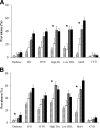Patterns of abdominal fat distribution: the Framingham Heart Study
- PMID: 19074995
- PMCID: PMC2646033
- DOI: 10.2337/dc08-1359
Patterns of abdominal fat distribution: the Framingham Heart Study
Abstract
Objective: The prevalence of abdominal obesity exceeds that of general obesity. We sought to determine the prevalence of abdominal subcutaneous and visceral obesity and to characterize the different patterns of fat distribution in a community-based sample.
Research design and methods: Participants from the Framingham Heart Study (n = 3,348, 48% women, mean age 52 years) underwent multidetector computed tomography; subcutaneous adipose tissue (SAT) and visceral adipose tissue (VAT) volumes were assessed. Sex-specific high SAT and VAT definitions were based on 90th percentile cut points from a healthy referent sample. Metabolic risk factors were examined in subgroups with elevated SAT and VAT.
Results: The prevalence of high SAT was 30% (women) and 31% (men) and that for high VAT was 44% (women) and 42% (men). Overall, 27.8% of the sample was discordant for high SAT and high VAT: 19.9% had SAT less than but VAT equal to or greater than the 90th percentile, and 7.9% had SAT greater than but VAT less than the 90th percentile. The prevalence of metabolic syndrome was higher among women and men with SAT less than the 90th percentile and high VAT than in those with high SAT but VAT less than the 90th percentile, despite lower BMI and waist circumference. Findings were similar for hypertension, elevated triglycerides, and low HDL cholesterol.
Conclusions: Nearly one-third of our sample has abdominal subcutaneous obesity, and >40% have visceral obesity. Clinical measures of BMI and waist circumference may misclassify individuals in terms of VAT and metabolic risk.
Figures


 , overweight; ▪, obese. C and D: □, normal waist circumference; ▪, high waist circumference.
, overweight; ▪, obese. C and D: □, normal waist circumference; ▪, high waist circumference.
 , low SAT and VAT; □, high SAT and low VAT;
, low SAT and VAT; □, high SAT and low VAT;  , low SAT and high VAT; ▪, high SAT and VAT.
, low SAT and high VAT; ▪, high SAT and VAT.Similar articles
-
Gender differences in the association of visceral and subcutaneous adiposity with adiponectin in African Americans: the Jackson Heart Study.BMC Cardiovasc Disord. 2013 Feb 22;13:9. doi: 10.1186/1471-2261-13-9. BMC Cardiovasc Disord. 2013. PMID: 23433085 Free PMC article.
-
Abdominal visceral and subcutaneous adipose tissue compartments: association with metabolic risk factors in the Framingham Heart Study.Circulation. 2007 Jul 3;116(1):39-48. doi: 10.1161/CIRCULATIONAHA.106.675355. Epub 2007 Jun 18. Circulation. 2007. PMID: 17576866
-
Impact of abdominal visceral and subcutaneous adipose tissue on cardiometabolic risk factors: the Jackson Heart Study.J Clin Endocrinol Metab. 2010 Dec;95(12):5419-26. doi: 10.1210/jc.2010-1378. Epub 2010 Sep 15. J Clin Endocrinol Metab. 2010. PMID: 20843952 Free PMC article.
-
Visceral adiposity and inflammatory bowel disease.Int J Colorectal Dis. 2021 Nov;36(11):2305-2319. doi: 10.1007/s00384-021-03968-w. Epub 2021 Jun 9. Int J Colorectal Dis. 2021. PMID: 34104989 Review.
-
Association between volume and glucose metabolism of abdominal adipose tissue in healthy population.Obes Res Clin Pract. 2017 Sep-Oct;11(5 Suppl 1):133-143. doi: 10.1016/j.orcp.2016.12.007. Epub 2017 Jan 7. Obes Res Clin Pract. 2017. PMID: 28073639 Review.
Cited by
-
Sex-specific HDL cholesterol changes with weight loss and their association with anthropometric variables: the LIFE study.Obesity (Silver Spring). 2011 Feb;19(2):429-35. doi: 10.1038/oby.2010.216. Epub 2010 Sep 30. Obesity (Silver Spring). 2011. PMID: 20885387 Free PMC article.
-
Differential association of anthropometric parameters with coronary risk in women--data of the CORA study.Obes Facts. 2011;4(5):358-64. doi: 10.1159/000333964. Epub 2011 Oct 14. Obes Facts. 2011. PMID: 22166755 Free PMC article.
-
Indexed Left Atrial Adipose Tissue Area Is Associated With Severity of Atrial Fibrillation and Atrial Fibrillation Recurrence Among Patients Undergoing Catheter Ablation.Front Cardiovasc Med. 2018 Jun 19;5:76. doi: 10.3389/fcvm.2018.00076. eCollection 2018. Front Cardiovasc Med. 2018. PMID: 29971239 Free PMC article.
-
Associations of visceral and liver fat with the metabolic syndrome across the spectrum of obesity: the AGES-Reykjavik study.Obesity (Silver Spring). 2011 Jun;19(6):1265-71. doi: 10.1038/oby.2010.291. Epub 2010 Dec 23. Obesity (Silver Spring). 2011. PMID: 21183935 Free PMC article.
-
Body fat distribution: a crucial target for intervention in nonalcoholic fatty liver disease and fibrosis.Hepatobiliary Surg Nutr. 2022 Oct;11(5):738-742. doi: 10.21037/hbsn-22-366. Hepatobiliary Surg Nutr. 2022. PMID: 36268244 Free PMC article. No abstract available.
References
-
- Flegal KM, Carroll MD, Ogden CL, Johnson CL: Prevalence and trends in obesity among US adults, 1999–2000. JAMA 288:1723–1727, 2002 - PubMed
-
- Bjorntorp P: Metabolic implications of body fat distribution. Diabetes Care 14:1132–1143, 1991 - PubMed
-
- Li C, Ford ES, McGuire LC, Mokdad AH: Increasing trends in waist circumference and abdominal obesity among US adults. Obesity (Silver Spring) 15:216–224, 2007 - PubMed
-
- Fox CS, Massaro JM, Hoffmann U, Pou KM, Maurovich-Horvat P, Liu CY, Vasan RS, Murabito JM, Meigs JB, Cupples LA, D'Agostino RB Sr, O'Donnell CJ: Abdominal visceral and subcutaneous adipose tissue compartments: association with metabolic risk factors in the Framingham Heart Study. Circulation 116:39–48, 2007 - PubMed
-
- Goodpaster BH, Krishnaswami S, Harris TB, Katsiaras A, Kritchevsky SB, Simonsick EM, Nevitt M, Holvoet P, Newman AB: Obesity, regional body fat distribution, and the metabolic syndrome in older men and women. Arch Intern Med 165:777–783, 2005 - PubMed
Publication types
MeSH terms
Grants and funding
LinkOut - more resources
Full Text Sources
Research Materials

